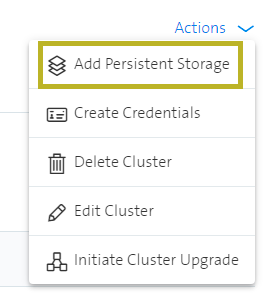Add persistent storage
All Kubernetes clusters come with a 1TB of persistent storage by default.
How to add extra storage
To add additional persistent storage to your Kubernetes cluster, choose "Add Persistent Storage" from the list of day-2 actions:

This opens up the "Storage" form where you could add 8TB storage containers:

You could submit your request and track its progress in the "Requests" tab.
How to use the new storage
CSI migration
Each cluster which has been created, updated or upgraded after 02.03.2023 is using the new CSI storage driver.
CSI driver
If your cluster is using the CSI storage driver then you do not need to do anything. Continue using the "caas-persistent-storage" storage class and the driver will take care to distribute your new PV requests to the new storage containers.
VCP driver
If your cluster still uses the legacy VCP storage driver, you need to create a storage class on your Kubernetes Cluster referring to the Storage Policy created for you. The policy name is displayed in the details of the cluster.
First create the storage class on your cluster using the Kubernetes API and a manifest such as this one, with the storagePolicyName set to the one of your cluster.
# Create a new Storage Class that uses Storage Policy to retrieve
# the list of datastore(s) that can be used
#
kind: StorageClass
apiVersion: storage.k8s.io/v1
metadata:
name: fast
provisioner: kubernetes.io/vsphere-volume
parameters:
diskformat: zeroedthick
storagePolicyName: sp_wl02_ucs1_ds_t0_wld_WL-All-Prd-01_1011
You can then create PVCs referring to this storage class such as in this example:
#
# Create a new PVC that uses the Storage Class defined above
#
apiVersion: v1
kind: PersistentVolumeClaim
metadata:
name: pvc-1
annotations:
volume.beta.kubernetes.io/storage-class: fast
spec:
accessModes:
- ReadWriteOnce
resources:
requests:
storage: 10Gi
storageClassName: fast
Restrictions
- You could add up to maximum 5 storage containers per request.
- You could not decrease the number of storage containers attached to your cluster automatically. You need to create a support ticket in such cases.
